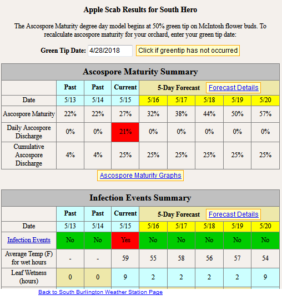Buds have broken in Vermont vineyards and many vines are at 1-3” short growth. This brings up a few pest management considerations for your vineyards. Most cold-climate cultivars will not need disease protection until 5-8” of shoot growth, but any vineyards with heavy disease pressure last year may wish to begin earlier, especially if inoculum reduction through thorough removal of diseased wood and mummy berries and/or dormant application of lime sulfur was not performed. I still recommend our fact sheet, An Initial Integrated Pest Management (IPM) Strategy for New Cold Climate Winegrape Growers as the best resource to boil the decisions down to a simple ‘prescription’, with the caveat that since it was written some new pest management materials have been released and inoculum may have increased in your vineyards which could lead to increased disease pressure. Growers should have an up-to-date copy of the New York and Pennsylvania Pest Management Guidelines for Grapes as a reference for specific materials, their efficacy, and use considerations. Remember however that the guidelines are written largely for vinifera and less disease-resistant hybrids, so the specific spray programs recommended may be overkill in Vermont vineyards.
The warm weather in the past few days may have increased emergence of grape flea beetle or cutworms. Grapes are susceptible through about the one inch shoot growth stage, so vines will eventually outgrow the threat. However, cooler temperatures over the weekend may hold the vines at this susceptible stage long enough for damage to increase to unacceptable levels. A scouting of your vineyard for feeding on swelling buds or developing shoots may be warranted. If damage is evident on more than 2% of buds, an insecticide treatment may be warranted. But if shoots expand rapidly over the weekend, don’t worry about this pest. More information may be found here.
Since buds at ground level have begun to emerge, applications of systemic herbicides should either be halted or very carefully controlled to prohibit contact with green tissue. Now is an appropriate time for cultivation in vineyards to manage weeds. It’s also a good time to keep water on newly planted or young vines. With soil warming and growth beginning, nitrogen fertilizer applications, if needed based on foliar analyses or observed low vigor last year, may also be made now.
Where trade names or commercial products are used for identification,
no discrimination is intended and no endorsement is implied.
Always read the label before using any pesticide.
The label is the legal document for the product use.
Disregard any information in this message if it is in conflict with the
label.
The UVM Tree Fruit and Viticulture Program is supported by the
University of Vermont Agriculture Experiment Station, a USDA NIFA E-IPM
Grant, and USDA Risk Management Agency Funds.

